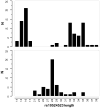Genetic variation at a single locus and age of onset for Alzheimer's disease
- PMID: 20298972
- PMCID: PMC2874876
- DOI: 10.1016/j.jalz.2010.01.011
Genetic variation at a single locus and age of onset for Alzheimer's disease
Abstract
This perspective article provides an opportunity to explain a new genetic finding for late-onset Alzheimer's disease (LOAD). It is specifically written for physicians and scientists who are interested in LOAD, but it may be relevant to those interested in identifying susceptibility variants for other complex diseases. The significant finding discussed here is that a variable-length, deoxythymidine homopolymer (poly-T) within intron 6 of the TOMM40 gene is associated with the age of onset of LOAD [Roses AD, Lutz MW, Amrine-Madsen H, Saunders AM, Crenshaw DG, Sundseth SS, et al. A TOMM40 variable-length polymorphism predicts the age of late-onset Alzheimer's disease. Pharmacogenomics J 2009 December 22;[Epublication ahead of print]. This result was obtained with a phylogenetic study of the genetic polymorphisms that reside within the linkage disequilibrium (LD) block that contains the TOMM40, APOE, and APOC1 genes from patients with LOAD and age-matched subjects without disease. Although the data will have diagnostic, prognostic, and therapeutic strategy implications, this perspective is meant to place the inheritance pattern for this "complex" human disease into context, and to highlight the potential utility of applying phylogenetic tools to the study of the genetics of complex diseases.
2010 The Alzheimer's Association. All rights reserved.
Conflict of interest statement
Conflict of interest statement: Dr. Roses is the President of three companies filed as S-Corporations in the state of North Carolina: Cabernet Pharmaceuticals, Inc is a pipeline pharmacogenetic consultation and project management company that has other pharmaceutical companies as clients; Shiraz Pharmaceuticals, Inc. is focused on the commercialization of diagnostics, including companion diagnostics, for universities, pharmaceutical companies, and biotechnology companies; Zinfandel Pharmaceuticals is the sponsor of OPAL [Opportunity to Prevent Alzheimer’s Disease] which is a combined clinical validation of a diagnostic and a pharmacogenetic-assisted delay of onset clinical trial.
These companies are independent of Duke University but any intellectual property generated by Dr. Roses or his team is intended to be treated as Deane Drug Discovery Institute property once there is an established commercial value.
Figures






Similar articles
-
A TOMM40 variable-length polymorphism predicts the age of late-onset Alzheimer's disease.Pharmacogenomics J. 2010 Oct;10(5):375-84. doi: 10.1038/tpj.2009.69. Epub 2009 Dec 22. Pharmacogenomics J. 2010. PMID: 20029386 Free PMC article.
-
The cis-regulatory effect of an Alzheimer's disease-associated poly-T locus on expression of TOMM40 and apolipoprotein E genes.Alzheimers Dement. 2014 Sep;10(5):541-51. doi: 10.1016/j.jalz.2013.08.280. Epub 2014 Jan 15. Alzheimers Dement. 2014. PMID: 24439168 Free PMC article.
-
Genetic Variants and Haplotypes of TOMM40, APOE, and APOC1 are Related to the Age of Onset of Late-onset Alzheimer Disease in a Colombian Population.Alzheimer Dis Assoc Disord. 2022 Jan-Mar 01;36(1):29-35. doi: 10.1097/WAD.0000000000000477. Alzheimer Dis Assoc Disord. 2022. PMID: 35149606
-
An inherited variable poly-T repeat genotype in TOMM40 in Alzheimer disease.Arch Neurol. 2010 May;67(5):536-41. doi: 10.1001/archneurol.2010.88. Arch Neurol. 2010. PMID: 20457951 Free PMC article. Review.
-
The effects of the TOMM40 poly-T alleles on Alzheimer's disease phenotypes.Alzheimers Dement. 2018 May;14(5):692-698. doi: 10.1016/j.jalz.2018.01.015. Epub 2018 Mar 7. Alzheimers Dement. 2018. PMID: 29524426 Free PMC article. Review.
Cited by
-
Warning SINEs: Alu elements, evolution of the human brain, and the spectrum of neurological disease.Chromosome Res. 2018 Mar;26(1-2):93-111. doi: 10.1007/s10577-018-9573-4. Epub 2018 Feb 19. Chromosome Res. 2018. PMID: 29460123 Free PMC article. Review.
-
NRG3 gene is associated with the risk and age at onset of Alzheimer disease.J Neural Transm (Vienna). 2014 Feb;121(2):183-92. doi: 10.1007/s00702-013-1091-0. Epub 2013 Sep 24. J Neural Transm (Vienna). 2014. PMID: 24061483
-
Modeling the dementia epidemic.CNS Neurosci Ther. 2012 Feb;18(2):175-81. doi: 10.1111/j.1755-5949.2011.00242.x. Epub 2011 Mar 21. CNS Neurosci Ther. 2012. PMID: 22070738 Free PMC article. Review.
-
The effect of TOMM40 poly-T length on gray matter volume and cognition in middle-aged persons with APOE ε3/ε3 genotype.Alzheimers Dement. 2011 Jul;7(4):456-65. doi: 10.1016/j.jalz.2010.11.012. Alzheimers Dement. 2011. PMID: 21784354 Free PMC article.
-
Genome-wide association study of hippocampal atrophy rate in non-demented elders.Aging (Albany NY). 2019 Nov 23;11(22):10468-10484. doi: 10.18632/aging.102470. Epub 2019 Nov 23. Aging (Albany NY). 2019. PMID: 31760383 Free PMC article.
References
-
- Corder EH, Saunders AM, Strittmatter WJ, Schmechel DE, Gaskell PC, Small GW, Roses AD, Haines JL, Pericak-Vance MA. Gene dose of apolipoprotein E type 4 allele and the risk of Alzheimer’s disease in late onset families. Science. 1993;261:921–3. - PubMed
-
- Khoury MJ, Bertram L, Boffetta P, Butterworth AS, Chanock SJ, Dolan SM, Fortier I, Garcia-Closas M, Gwinn M, Higgins JP, et al. Genome-wide association studies, field synopses, and the development of the knowledge base on genetic variation and human diseases. Am J Epidemiol. 2009;170:269–79. - PMC - PubMed
Publication types
MeSH terms
Substances
Grants and funding
LinkOut - more resources
Full Text Sources
Other Literature Sources
Medical
Research Materials
Miscellaneous

